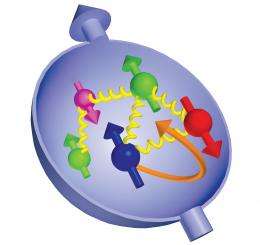Physicists develop theoretical framework for interpreting results of subatomic-particle collisions

Accelerating subatomic particles to almost the speed of light and then crashing them together reveals much about the nature of the matter. Nuclear physicists need to fully understand these complex collisions if they are to make sense of the large volume of experimental data the world’s particle accelerators generate every year. RIKEN scientists Zhong-Bo Kang and Feng Yuan, and their colleague Bo-Wen Xiao from Penn State University, USA, have presented a new theoretical framework that should accurately model one important type of interaction in particular: proton collisions.
The protons and neutrons at the heart of every atom are made up of fundamental entities known as quarks and antiquarks that are held together by a strong nuclear force mediated by so-called gluons (Fig. 1). “One of the most important goals in nuclear physics is to explore the structure of the protons and neutrons in terms of their internal constituent partons—the collective name for quarks and gluons,” explains Kang from the RIKEN BNL Research Center, USA.
When physicists smash two high-energy beams of protons together, they decay to create new particles that shoot off in all directions. Measuring how the momentum of colliding particles is distributed among the collision remnants is a crucial tool for investigating the distribution of the quarks within a proton.
The latest theoretical framework, a development led by Yuan from the RIKEN BNL Research Center, considers collisions in which the protons in one beam are spin polarized; that is, the axis about which each proton rotates is perpendicular to the beam’s propagation direction. The outcome of the collision is dependent on the direction of spin—a phenomenon known as single-spin asymmetry. “In the past few decades, we have learnt a lot about the ‘longitudinal’ motion of partons in the proton. But we don't know much about their ‘transverse’ motion,” explains Kang. “It turns out that single-spin asymmetry is a sensitive and direct probe of the partons’ transverse motion.”
Previous numerical predictions of single-spin asymmetries have only gone as far as first order calculations. Yuan, Kang and colleagues work extends the model to the next level, providing more reliable predictions. “We have developed a theoretical formalism such that we can precisely extract information about the transverse motion of the partons from the experimental data,” says Kang. “Knowing about both the longitudinal and the transverse motion of partons will enable us to construct three-dimensional images of a proton for the first time.”
More information: Kang, Z.-B., et al. QCD resummation for single spin asymmetries. Physical Review Letters 107, 152002 (2011).
Provided by RIKEN





















